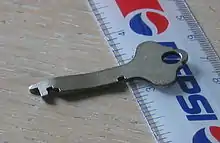Matthew Manning
Matthew Manning (born 17 August 1955) is a best selling British author and healer, alleged to have psychic abilities. As a child he and his family were allegedly subjected to a range of poltergeist disturbances in their Cambridge home and later at Oakham School.[1]
Matthew Manning | |
|---|---|
| Born | 17 August 1955 |
| Nationality | British |
| Occupation | Author and psychic |
Life

In the 1960s, it was alleged that Manning was the focus of poltergeist activity. He started performing automatic drawing and writings. Covering his bedroom walls appeared over six hundred signatures spanning six centuries.[2] It was noted at the time that Manning had been researching history as part of his school work. According to Joe Nickell who made an in-depth study of Manning's writings, they contain internal inconsistencies and the "signatures" are completely inaccurate for historical individuals. Nickell concluded that Manning has "traits associated with a fantasy-prone personality" and there is no evidence he possesses genuine paranormal powers.[2]
Regarding his automatic drawings, he claimed to draw in the styles of many famous artists including Pablo Picasso. Manning told The San Francisco Examiner that an art expert at Sotheby's in London had thought one of his Picasso copies so good it might be mistaken for an original. The sceptic James Randi investigated this claim by writing to the gallery. A Sotheby's official replied that the claim was "absolutely not true" as they were forgeries of existing works.[3] Manning told the London Daily Mirror his drawing of a monkey had caused "great excitement" because it was strikingly similar to an original by Jan Savery that the Rijksmuseum kept locked away from public display in a vault. This was also investigated by Randi who wrote a letter to the museum and it was discovered the claim was false as the original was on display to the public, not locked up in a vault.[3]
Manning was also tested for psychokinetic abilities by parapsychologist William G. Braud of the Mind Science Foundation in the late 1970s, with results that, according to Braud and coauthors in a psychical research paper published in 1979, were better than chance.[4][5] Additionally during this time, it was reported that he could "bend metal paranormally, affect electrical equipment, move compass needles, and make medical diagnoses."[6] The magician John Booth has written Manning's metal bending is a magic trick performed while lightly stroking the object.[7] The physicists John Taylor and Eduardo Balanovski tested Manning in distance viewing and the results proved "completely unsuccessful".[8]
The events of his childhood and later investigations by George Owen of the Cambridge Psychical Research Society[9] were published in a 1974 book entitled The Link.
Bibliography
- The Link : The Extraordinary Gifts of a Teenage Psychic. Colin Smythe Ltd (1974) ISBN 0-86140-283-9
- In The Minds Of Millions. W.H. Allen / Virgin Books (1977) ISBN 0-491-02340-5
- The Strangers. W.H. Allen / Virgin Books (1978) ISBN 0-491-02333-2
- Matthew Manning's Guide To Self Healing. (Foreword by Brian Roet) HarperCollins Publishers Ltd (1989) ISBN 0-7225-1626-6
- No Faith Required. Colin Smythe Ltd (1995) ISBN 82-90601-09-3
- One Foot in the Stars. Piatkus Books (1999) ISBN 0-7499-2463-2
- The Healing Journey. Piatkus Books (2002) ISBN 0-7499-2308-3
- Your Mind Can Heal Your Body. Piatkus Books (2007) ISBN 0-7499-2712-7
References
- Anderson, Roger (2006). Psychics, Sensitives and Somnambules. McFarland & Company. p. 110. ISBN 0-7864-2770-1
- Nickell, Joe. (2015). "Poltergeist Scribbler: The Bizarre Case of Matthew Manning". Skeptical Inquirer. Retrieved 30 April 2016.
- Gordon, Henry. (1988). Extrasensory Deception: ESP, Psychics, Shirley MacLaine, Ghosts, UFOs. Macmillan of Canada. pp. 101–102. ISBN 0-7715-9539-5
- Questia.com Library Journal
- Haynes, Renée. (1982). The Society for Psychical Research, 1882–1982: A History. Macdonald. p. 138. ISBN 0-356-07875-2.
- Berger, Arthur S.; Berger, Joyce (1991). The Encyclopedia of Parapsychological and Psychical Research. New York: Paragon House. pp. 255–256. ISBN 1-55778-043-9. "He also found that he could bend metal paranormally, affect electrical equipment, move compass needles, and make medical diagnoses. ... Manning has turned to healing in an attempt to prove that we are all interconnected."
- Booth, John (1986). Psychic Paradoxes. Prometheus Books. p. 57. ISBN 0-87975-358-7.
- Taylor, John (1980). Science and the Supernatural: An Investigation of Paranormal Phenomena Including Psychic Healing, Clairvoyance, Telepathy, and Precognition by a Distinguished Physicist and Mathematician. Temple Smith. p. 83. ISBN 0-85117-191-5.
- Richard Cavendish and Brian Innes. (1995) [1970]. Man, Myth & Magic: The Illustrated Encyclopedia of Mythology, Religion, and the Unknown. New York: Marshall Cavendish Corporation. p. 1626, v. 12. ISBN 1-85435-731-X. OCLC 228665658. Entry for Matthew Manning. Mentions separate lab experiments with Owen and Braud; automatic drawing, metal bending, and healing.
Further reading
- Braud, W., Davis, G., & Wood, R. (1979). Experiments with Matthew Manning. Journal of the Society for Psychical Research 50: 199–223.
- Nickell, Joe. (2015). "Poltergeist Scribbler: The Bizarre Case of Matthew Manning". Skeptical Inquirer.